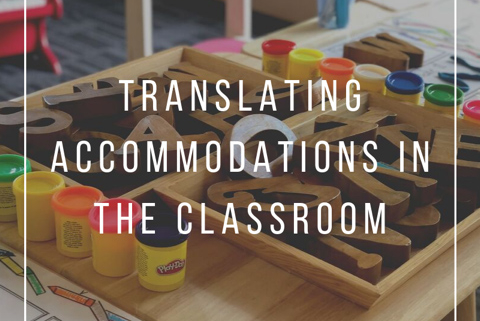Accommodations Translated, Pt. I
The IEP and 504 process can be overwhelming. With so many aspects, considerations, components, and details, the documentation can be dizzying for families. One major piece of the puzzle that is crucial to understand is the list of the student’s accommodations—these are the specific supplementary aids and services that are legally guaranteed to students to assist in their learning. However, often times the terminology and phrasing can be unclear for families, especially those who are unfamiliar with clinical “teacher speak.” So what do some of the more commonly confusing accommodations actually mean for families? Let’s take a look!
- First of all, accommodations are typically categorized into 4 groups: setting, presentation, response, and timing.
- Setting involves an adjustment to the learning environment that is more conducive to the student’s learning needs. This could mean “reduced distractions” and/or “small group testing,” which we’ll explain more thoroughly later.
- Presentation refers to the way in which the material is offered or presented to the student. An example might be to supplement a required reading with the option to listen to an audio recording of the same text.
- Response accommodations refer to the manner in which the child answers or completes a task or assignment. Access to a Word Processor, for example, is a common accommodation for students with dysgraphia.
- Timing, as it sounds, involves the child’s school schedule and/or allotted time for task completion. For instance, a child with ADHD may benefit from taking more rigorous courses first thing in the morning, as opposed to having content-heavy classes after lunch.
- Additionally, there is an important distinction between accommodations and modifications.
- Accommodations are put in place to help students with various learning difficulties to circumvent their challenges or disabilities. However, accommodations do not alter the expectations for learning; nothing is “watered down” or simplified, as some parents often misconceive.
- Modifications do change the content or amount of the information that the child is required to learn. For instance, instead of completing a timed 30–question multiplication quiz, students with a modified workload might have to answer 15 questions.
Another common misconception involves a widely-used accommodation—preferential seating. Contrary to what many parents assume, preferential seating doesn’t necessarily mean in the front and center of the classroom. This accommodation actually means that the student should be seated wherever he or she will be most successful and have optimal access to instruction. That said, preferential seating could mean different things for different students; it could also mean different seating from class to class. For example, a student who becomes easily distracted by visual stimuli might need to face away from the windows in one classroom, but away from the doorway/hallway in another.
In order for the accommodation to be truly beneficial, the decisions being made about seating should be a collaborative effort among the IEP team and the student. Open communication is key here. It is also important to note that preferential seating can be a fluid arrangement; if seating does not appear to be successful, teachers should discuss with the student and rethink what “preferential” should look like moving forward.







